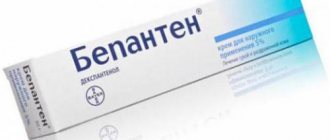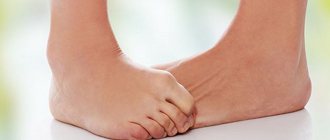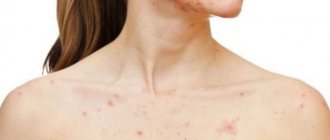A boil, or boil, is an inflammation that is localized in the hair follicle and nearby tissues. The disease occurs due to exposure to Staphylococcus aureus. The boil appears where the hair follicles are located, infection occurs through the sebaceous duct. A boil often forms on:
- hands;
- legs;
- face;
- buttocks.
The disease can appear if the affected skin comes into contact with clothing.
Causes of furunculosis
Staphylococcus is almost constantly present on the epidermis of people. But it causes pathological processes only if favorable conditions for reproduction arise. A boil can spring up when the body's defenses are reduced. Also have an adverse effect:
- lack of hygiene;
- increased sweating;
- open skin injuries.
Typically, a boil is found where the leg rubs against the leg. The problem is especially relevant for overweight people. When the inner thighs come into contact while walking, a sore area forms in that area. It represents the “gate of entry” for infection. This also applies to cuts and microcracks.
After suffering viral diseases and bacterial infections, the body's resistance decreases. As a result, staphylococcus receives a favorable environment for its life. It multiplies, thereby provoking a pathological process. Hypothermia can also cause furunculosis.
For a strong immune system, a person must eat properly. The lack of fresh fruits and vegetables and nutritious foods helps reduce the body's resistance. Junk food increases the risk of infectious foci several times. A predisposing factor for the occurrence of a boil is diabetes mellitus. This is also true for other types of hormonal imbalance.
If diabetic neuropathy has developed, the likelihood of encountering furunculosis increases. Diabetics often do not notice calluses, wounds and boils, as their sensitivity to pain is reduced.
For this reason, a purulent process is formed that lasts a long time. The so-called diabetic foot is one of the causes of furunculosis on the leg. Nerve communication is disrupted here, as is blood flow. The little finger and thumb are supplied with the least amount of blood.
The area near the groin and inner thighs require special hygiene. Sweating is common here. Irregular sanitation creates conditions for the spread of microbes, and a large number of hair follicles contributes to the risk of furunculosis. The follicles are blocked by keratinized epidermal cells and dirt. As a result, microbes accumulate and begin to multiply rapidly. Ethanol can also favor susceptibility to bacteria, so alcohol abuse is undesirable if you want to avoid furunculosis.
Folk remedies
The use of traditional methods should be treated with extreme caution. You should not use them on your own - only after consultation with your doctor. For mild pyoderma in the early stages, the following remedies can sometimes be used:
- A mixture of celandine and sunflower oil.
- Infusion of dandelion roots and leaves.
- Compresses with grated potatoes.
- Infusion of poplar buds, dill seeds.
- Compress made from plantain or coltsfoot leaves.
The maturation of the abscess can be accelerated with ointments based on oleoresin, oil, and honey. Tincture of Japanese Sophora, baked onions, rye flatbread - these remedies will also help get rid of boils. But it should be remembered that folk methods in no case can be considered as an alternative to traditional ones. Delayed and inadequate treatment of purulent processes is associated with dangerous complications.
Symptoms of the disease
Boils can occur anywhere. Most often it is localized on the thigh, near the groin, and on the calves. Quite often it is found under the knee. Occasionally a boil forms on:
- heels;
- knees;
- back of the foot.
It does not occur on the soles, since there are no hair follicles in this area. A core consisting of necrotic cells is formed in the structure of the boil. On the epidermis you can see a purulent white tip. On the fifth day, the boil matures. Its structure is filled with pus. The first two stages include the formation of infiltrate and suppuration. Initially, a person experiences pain, which becomes maximum at the time the boil ripens. Further, by the time the boil matures, the pain dulls. Blood mixed with pus appears on the surface of the skin.
The rod, consisting of necrotic tissue, does not always come off immediately. Sometimes it takes a while, in which case it contains blood and pus. Symptoms include:
- tingling of the skin;
- general weakness;
- soreness.
The malaise is explained by intoxication, which is caused by damage to immune cells. When boils are located nearby, the clinic may intensify. Large elements leave deep ulcers after ripening. A small chiryak in most cases goes away without any traces.
After healing, slight pigmentation is visible on the affected area. Furunculosis may be characterized by relapses. If purulent formations appear regularly, you should consult a doctor.
Recommendations
To prevent the appearance of paronychia in a child or adult, it is necessary to trim nails using special tools that undergo antiseptic treatment before use. If tissue integrity is compromised, the damaged area should be treated and a bandage applied.
Using protective gloves will help reduce the likelihood of developing an inflammatory process on your fingers. Timely manicure and pedicure will help prevent ingrown nails.
Regardless of whether there are damaged areas on the skin, you should always ensure that your hands and feet are clean. Pathogenic microflora (with reduced immunity) can penetrate microcracks in the epidermis and cause the development of an inflammatory process.
Treatment methods
Contact with clothing or shoes that creates friction can cause a boil on the leg. A dermatologist can tell you how to treat such inflammation. Inflammation in the lower limb contributes to discomfort as it blocks the ability to move freely. It is especially difficult for patients whose chiryak has formed on the heel, near the nail and between the legs. This is usually caused by the pressure of shoes, clothing or feet rubbing against each other. The sooner treatment for a boil on the leg is started, the faster it will mature. Accordingly, there will be less likelihood of complications. The main methods of therapy are medication and surgery.
Application of ointments
In the initial stages of pathology, local remedies can be used. Ointments are used in bandages in a dense layer. There is no need to rub them in. At the infiltration stage, local preparations are used, which trigger the process of chiryak maturation. The most popular ointments:
- Ichthyol. The active component of the product is sulfuric acid. The drug must be applied for several hours at short intervals. After removing the compress, the ointment is applied again. A strong antiseptic effect is a characteristic feature of this medicine. It is also affordable.
- Heparin. It eliminates swelling around the boil and helps relieve pain.
- Vishnevsky ointment. Liniment is applied several times a day in a thick layer and fixed with a bandage. This remedy does a good job of removing purulent contents. It has a pronounced antimicrobial effect. Balsamic liniment also speeds up the regeneration process.
By making bandages with antibacterial ointments, you can quickly remove a boil on your leg. How to treat in the case of more complex forms should be determined by a specialist after analyzing the individual characteristics of the body.
Antibiotic ointments are not always indicated. They are used for large boils, recurrent forms of furunculosis and in patients with weakened immune systems. Levomekol ointments, medicinal products with oflocaine and tetracycline are used. If the pain causes significant discomfort, anesthetic ointments are required. It is good to use Lidocaine, as well as local novocaine-based products. At the same time, only the boil itself is smeared. The healthy skin around it is not touched. It is advisable to use zinc ointment at the stage of healing of boils. It dries out damaged areas and starts the regeneration process in cells.
Antibacterial agents
Antibiotics are quite effective in the fight against furunculosis. The main purpose of their use is to stop the spread of infection. Antibiotics in tablets and injections penetrate the bloodstream and fight Staphylococcus aureus. Blockade of the boil is used only for dangerous forms of the disease. It includes an antibacterial component and Novocain.
Pecking the abscess helps prevent infection of healthy tissue. The most popular antibiotics are tetracyclines and cephalosporins. Broad-spectrum antibacterial agents are also used as prescribed by a doctor. The course of treatment varies from 1 to 2 weeks.
List of physiotherapy procedures
The use of laser is quite popular today to treat the disease. Electrophoresis with antimicrobial compounds, infrared irradiation and dry heat are used. Classic UHF methods are complemented by the use of a laser, which has many advantages, including speed of manipulation and safety.
The laser is suitable for the treatment of furunculosis in pregnant women. This is a non-contact method, one of the most modern today. Laser therapy does not cause scars on the skin. Such treatment is allowed at any stage of the disease.
Surgical intervention
If the damage covers a large area or the boil does not open on its own, the help of a surgeon is required. Local anesthetics are used to perform the manipulation. The chiryak is cut crosswise, after which the pus is waited for to come out. After the operation, a special wound healing bandage is applied.
You cannot squeeze out such a formation on your own. If his head has not formed, then this is especially dangerous. This can cause pus to enter the bloodstream and cause sepsis.
ethnoscience
Boils on the knee and hips can be cured using home methods in the initial stages. At this time, the affected area looks like a small inflammation. If the boil on the leg has progressed to the infiltration stage, specialized help is required.
The use of simple and cheap means is allowed. An example is table salt, which is prepared in the form of a solution. Make a steep solution and dip a gauze bandage into it. Wrap it around the affected areas to draw out the pus.
The combination of aloe leaves with honey is common among people. It is believed that baked or raw onions can help in the fight against boils. To do this, half a vegetable is applied to the boil for several hours. Carry out this procedure 3 times a day.
What to do if you find a boil
At the first signs of illness, you need to wash your hands and treat the affected area with hydrogen peroxide. If you don’t have it on hand, you can use green paint. After this, Vishnevsky or ichthyol ointment is applied to the skin and secured with a tight bandage. If scarring is observed, it is necessary to lubricate the wound with iodine.
There are cases when a boil on the leg does not mature, this means that the inflammation is localized under the skin, but the pus cannot come out. In this case, the likelihood of complications increases, you should consult a doctor. The surgeon will perform pain-relieving procedures using antibiotics, then make an incision and remove the pus. Upon completion of the intervention, a disinfectant composition is applied, and the doctor applies a bandage with crystalline salicylic sodium.
Possible complications
People often try to treat boils at home. This is the wrong approach, since tumors are often disguised as it. If you try to get rid of them using folk remedies , you can cause significant harm to the body. Opening an abscess on your own risks infecting healthy tissues and blood. As a result, the infection spreads and causes erysipelas, abscesses and cellulitis. When two boils unite, a carbuncle is formed - a purulent inflammation.
Particular attention should be paid to formations on the leg near the groin. This is explained by the presence of nearby lymphatic vessels. If an infectious agent enters them, lymphadenitis may develop. Proximity to the joint is dangerous in the case of a patient who has rheumatoid arthritis.
General information
Treatment tactics depend entirely on the diagnosis. Before prescribing anything, the doctor will conduct an examination and determine the nature of the pathology. When they talk about an abscess on the leg, they may mean the following diseases:
- Furuncle.
- Carbuncle.
- Felon.
- Abscess.
Each condition has certain morphological and clinical features. For example, boils and carbuncles affect hair follicles with sebaceous and sweat glands, with felon the fingers become inflamed (often near the nail), and an abscess is accompanied by the accumulation of pus in the soft tissues. Despite this, many treatments are based on similar principles.
Preventive actions
Maintaining hygiene helps to avoid furunculosis. You should also strengthen your immune system, eat right and ensure your body gets enough vitamins and minerals. A person must do everything possible to avoid hypothermia and overheating of the extremities. If he happened to suffer from an illness, he should devote all his efforts to recovery. A weakened body is most vulnerable to an attack by staphylococcus.
If there is a recurrent form of the disease, preventive therapy is required. It is carried out with a frequency of 1 time in 2 months. Control of sugar levels during the formation of boils is required for people with diabetes.
General conclusions
Most problems with boils and their consequences arise from non-compliance with hygiene rules. Once cured, the disease does not guarantee the acquisition of immunity - you can get a boil several times in a row. An operation performed to remove an abscess does not mean that the leg will not develop boils if hygiene standards are abandoned.
Ointments prescribed by a doctor have a local effect without affecting the patient’s body as a whole. Treatment cannot be limited to one ointment, as with folk remedies - it must be comprehensive and cover the entire body of the patient. If the infection spreads, the disease will not be limited to one leg - it will spread to all areas of the skin, including the face. An abscess can pop out both in the eyes and genitals.
If you refuse specific treatment, the matter will not end with one boil - furunculosis will develop with the constant appearance of new colonies of abscesses.
If a child's finger is torn
An abscess on a finger in children is a common phenomenon. A splinter that is not removed in time or a cut that has festered leads to a similar problem. The infection quickly penetrates the wounds through dirty hands or feet and begins to quickly spread inside.
A child picks a nail
https://www.youtube.com/watch?v=eaXqPMbdPKo
If a child begins to complain of pain in a finger, you need to take measures:
- prepare a herbal solution from chamomile, St. John's wort and calendula;
- ask the child to hold the inflamed area of the finger in the solution for 15-20 minutes. The solution can be prepared from potassium permanganate, after which the inflamed area should be wiped dry and treated with brilliant green. After 3-4 hours, check the condition of the finger.
If the inflammation does not go away and the swelling does not subside, you need to apply Vishnevsky ointment. Despite the pungent odor, the ointment actively fights bacteria, destroying their flora, and the abscess matures faster. You need to check the condition of your finger the next day.
Note If the ointment does not help, there is no improvement, the swelling of the finger quickly spreads to neighboring areas, then you need to consult a surgeon urgently.
It is worth considering that during the first day after a cut and suppuration, only a small abscess on the finger can be eliminated. If after a day there is no improvement, the abscess does not go away, self-medication is unlikely to help, it is better to go to the doctor.










